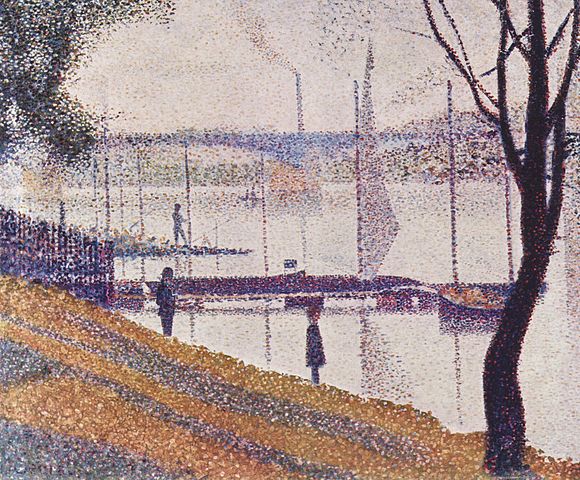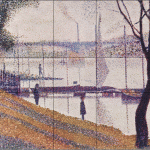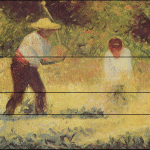Georges Seurat (1859–1891) was a French Post-Impressionist painter, who according to Wikipedia, “is noted for his innovative use of drawing media and for devising the technique of painting known as pointillism.” 
It continues, “His large-scale work A Sunday Afternoon on the Island of La Grande Jatte (1884–1886) altered the direction of modern art by initiating Neo-impressionism. It is one of the icons of late 19th-century painting.”
Did Seurat “attack every canvas with the Golden Ratio?”
The book “Mathematics” by David Bergamini stated that Seurat’s painting “La Parade de Cirque” contains numerous examples of Golden Proportions” and includes a quotation attributed to “one art expert” (identified in the book The Golden Ratio by Dr. Mario Livio as Matila Ghyika) that Seurat “attacked every canvas with the golden ratio.” A very interesting claim indeed, but is it true? Others say it’s but a myth to be dispelled.
Maybe not “every” canvas, but apparently a third or more
There’s also a quotation that says “a picture is worth a thousand words”, so rather than offer another 10,000 or more words on the subject, below are twelve Seurat paintings with golden ratio lines overlayed using PhiMatrix golden ratio design and analysis software. Click on any of them for a larger image with more clarity of the features and lines. Of the 103 Seurat paintings shown at Wikimedia Commons, these 12 below and about 20 more (see page 2) show evidence of at least one significant composition line or element whose placement appears to have been based on a conscious decision to apply the golden ratio.
Golden Ratios on canvas height and width, not arbitrary points
De-constructing an artist’s intent and method of art composition can seem arbitrary when applied to design elements within a painting. In all the paintings analyzed, the golden ratio lines are simply based on the height and width of the canvas to eliminate any possibilities that the dimensions analyzed were based on arbitrary points. Not all of Seurat’s paintings show golden ratios like the ones shown below and the other 20. Accordingly, it may be difficult to conclude that Seurat “attacked every canvas” with golden ratios, but it seems that he used the golden ratio in the basic composition in at least a third of his paintings.
Golden Ratio tools make it easy. Lack of bias makes it accurate.
There are many claims made about whether various artists used the golden ratio, even Leonardo Da Vinci, who created the illustrations for the book “The Divine Proportion” by his contemporary, Luca Pacioli. To make accurate assessments, you need tools that can easily identify golden ratio proportions, and an approach to the search that is unbiased, either for or against, with respect to appearances of the golden ratio. It may be that other golden ratios can be found in the various lines and focal points within many of Seurat’s paintings as well, but I’ll leave that to you the reader to pursue in more depth and to come to your own conclusions. Wikipedia Commons has a good collection of images of the paintings of George Seurat as a great place to start, and PhiMatrix has a free two week trial for you to use in your investigation. Click on any image below for a larger version:
- Golden ratio at horizon, left shore and feet
See more detailed analysis on Page 2















A set of numbers with a Phi common denominator actually does help in ordering a graphic composition. Thank you for the examples!
I did a few more Seurat examples that really stand out. He really was fond of placing his horizons on golden sections in his compositions. I find the debunking articles and even books by scholars (who invariably never present any evidence) absurd. Especially with so much evidence and experts who point out how it is just a fact.
https://www.behance.net/wip/1650462
https://www.behance.net/wip/1651980
Hi John. Thanks for your contributions to http://www.GoldenNumber.net and the PhiMatrix Facebook page. Your posting re Seurat’s “Le Jardinier” inspired me to review again all 103 paintings listed at https://commons.wikimedia.org/wiki/Georges_Seurat. There I found about 25 paintings whose proportions were very close to golden rectangles. I’ve added my review of these 25 paintings to page 3 of this article at https://www.goldennumber.net/georges-seurat-golden-ratio-in-art/3/, with a credit to you. I also listed on you the GoldenNumber.net Contributors page at https://www.goldennumber.net/contributors/. Keep those findings coming.
John, Gary, The Golden Rectangle has been a basis for my paintings for some time, I would appreciate a couple of minutes of your time to check out my site at http://carlo-fiorentini.sitelio.me
Hello Carlo. Thanks for sharing. Very nice work. I like the geometric designs with the shading and texture of a more realistic style.
Gary, Thank you for looking.